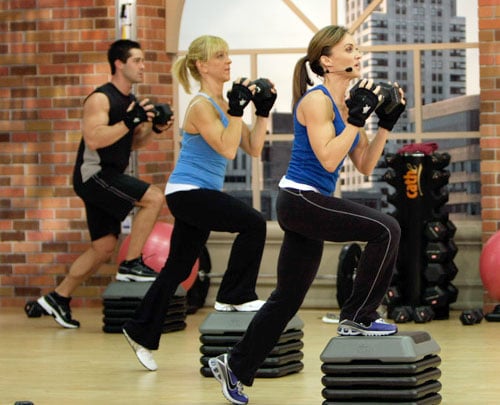Moderate-intensity exercise like jogging or cycling long distances is a popular way to stay in shape, but in the past few years another type of workout, high-intensity interval training has been growing in popularity. The advantages of high-intensity training are numerous. High-intensity workouts improve aerobic capacity as well as anaerobic fitness. Many of the moves you do with high-intensity training are fast and intense so you’re building power too. Who doesn’t want to get rid of belly fat? Some studies show high-intensity workouts burn more total fat, especially belly fat while improving insulin sensitivity. Plus, it’s a super time-efficient way to work out. You can get a fat-burning workout in as little as 15 minutes.
High-Intensity Workouts and EPOC
One reason high-intensity exercise is so effective is due to the afterburn effect. Afterburn or excess post-exercise oxygen consumption (EPOC) refers to the fact that you continue to use oxygen and burn fat at a higher rate for hours after you finish a high-intensity workout.
Because high-intensity training places greater demands on your body, your body has to work harder to recover – to metabolize lactic acid, bring your core body temperature down, slow down our breathing, replenish muscle glycogen stores, etc. That burns calories! Whereas when you exercise at a moderate intensity your body recovers relatively quickly and EPOC is limited.
Obviously, when you do a high-intensity workout you want to maximize the afterburn since a greater EPOC means you’ll burn fat at a higher rate for hours after you’ve finished. One question this raises is what role does diet play in the post-exercise afterburn? Will fasting before a high-intensity workout increase or decrease the afterburn?
Calorie Restriction and the Afterburn
In a study published in the journal Menopause, Japanese researchers looked at the effect calorie restriction had on the afterburn. They were interested in the effect cutting calories had on EPOC and whether this effect varied depending upon where a woman was in her menstrual cycle. They asked some of the women to eat a calorie restricted diet, half of what would be appropriate for them, the day before their workout. The other half ate an appropriate number of calories.
The women worked out for an hour at 70% of their V02 max on a cycle, an intensity high enough that it was difficult to carry on a conversation. All of the women had been previously sedentary so this was a relatively intense workout for them.
Did calorie restriction make a difference? It did. Calorie restriction reduced EPOC under all conditions. Where the women were in their menstrual cycle didn’t make a difference. What does this mean? Excessive calorie restriction may reduce the number of calories you burn after your workout is over. This is another reason not to limit calories too much when you’re trying to lose weight.
Fasting and High-Intensity Workouts
What about doing a high-intensity workout in a fasted state? Some studies show doing cardio when you’re fasting forces your body to oxidize fat as a source of fuel since muscle glycogen stores are low and cortisol levels are high after a fast. Oxidizing more fat sounds like a good idea but there are problems with this approach. During high-intensity exercise, carbohydrates are the preferred fuel source, not fat.
If you’re exercising intensely in a fasted state your blood sugar and glycogen stores are low. This will likely limit the intensity of your workout. The two factors that determine the degree of afterburn you get after a workout and how long it last is the intensity of a workout and the duration. There is a baseline level of intensity below which the afterburn is minimal. In other words, low-intensity exercise gives a negligible EPOC.
When you limit the intensity or duration of your workout you limit the afterburn. Plus, as mentioned, your cortisol level is higher after fasting. Cortisol boosts fat oxidation but it also increases protein breakdown so your body can convert the amino acids to glucose to maintain your blood sugar level. This happens through a process called gluconeogenesis. Unfortunately, it’s drawing amino acids from your muscle tissue – not what you want.
The Bottom Line?
To beef up the after-burn or EPOC you get after a workout, you need to maximize the intensity of your workout. You’re going to have problems doing that after an overnight fast when your muscle glycogen stores are low. Not all studies support the greater fat burning benefits of moderate-intensity fasted cardio, much less high-intensity cardio.
You can best maximize the intensity of a high-intensity workout by eating a small meal, around 20-30 grams of complex carbs and 10-20 grams of protein about an hour before a workout. A cup of yogurt with fruit, cottage cheese with berries, oatmeal, or an apple with peanut butter spread on top. This will give you enough energy to get through a tough HIIT workout without “hitting the wall.” It’ll also help preserve your hard-earned muscle mass. Fasted cardio is best reserved for days when you’re doing a lower intensity workout.
References:
Resistance Training and EPOC. Jeff M. Reynolds and Len Kravitz, Ph.D.
Menopause 16(1): 66-72. Jan-Feb 2009.
Exercise After-Burn: A Research Update. Jeff M. Reynold and Len Kravitz, Ph.D.
International Journal of Obesity (2008) 32, 684-691; doi:10.1038/sj.ijo.0803781
Related Articles By Cathe:
These Are the Two Biggest Factors that Determine How Much of an Afterburn You Get
Nutrient Timing: How Important Is It?
Tips for Timing Your Pre and Post-Workout Meals
4 Factors that Determine What Fuel Source You Use During Exercise
How Much Glycogen Can Your Body Store?
Refueling After a Workout: Your Muscles Are Screaming for Glycogen
Related Cathe Friedrich Workout DVDs:
HiiT and Interval Workout DVDs


